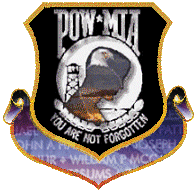|
|
It
is widely known that recovery and/or repatriation efforts have
been on-going around the world for quite some time now. Remains
of our heroes from World War II surface around the globe several
times a year and the U.S. has been working with Vietnam, Laos,
and Cambodia since the mid-to-late 1980's. In 1999, the U.S.
began talking with North Korea about efforts to recover the
remains of American soldiers from the Korean war. Why, I ask,
did they begin in 1999 (46 years after war's end)? Why not at
the end of the Cold War...or in 1954 for that matter?
It is quite unfortunate that, during
the December meetings, the North Korean Government felt it
necessary to use our Heroes and loved ones as bargaining tools
for receiving future aid from the United States. United States policy has, for years, been that it would not pay for
the remains of its own soldiers. On February 4th, North Korea
agreed to rejoin the U.S. at the table in light of supposed
recent findings (an unconfirmed 405 - 415 American remains).
Will this begin a new attempt in extortion? {See sidebar for updated information pertaining
to this subject}
The circumstances surrounding the
'remains-for-aid' demands of the North Koreans are reminiscent
of the tragedies that fell upon our POW/MIAs at the end of the
Vietnam War. During the negotiations that led to the signing of
the Paris Peace Accords, the U.S. and North Vietnam were working
out various issues, to include the release of our POWs. One of
the mistakes that the U.S. Government made had been accepting and
acknowledging a list of POWs provided by the North Vietnamese
(believe it or not, this happened after the end of the Korean
War as well) --
when in fact our intelligence reports indicated that the numbers
listed were extremely shallow, -- our reports indicated a much
larger number of POWs.
According to a 1992 issue of U.S. News
& World Report {Sept 28, 1992 v113 n12 p36(3)} Lawrence
Eagleberger, who was the acting Assistant Secretary of Defense
during the Nixon Administration, held in his possession an
estimate by the Defense Intelligence Agency (DIA). That estimate
showed that at least "350 Americans" remained
unaccounted for in Laos. On March 29, 1973, Eagleberger
forwarded this estimate to the White House along with his
recommendation for several diplomatic and military alternatives
to gain their release; this was just one day prior to Nixon's
famous statement declaring that all Americans held prisoner in
Southeast Asia were free. At the same time, Henry Kissinger --
the man responsible for negotiating the Paris Peace Accords on
behalf of Pres. Nixon, held in his possession a Department of
Defense list of 80 servicemen who remained unaccounted for in
Laos. Although the figures were of POWs in Laos, and not
Vietnam, it just goes to show that their were more men there
than Vietnam was willing to account for.
Moreover, according to the same article
listed above, Nixon had, on March 20, 1973, been advised of
North Vietnam's failure to account for 10 American [and
Canadian] prisoners -- prisoners that had been confirmed by
Department of Defense as "being under Viet Cong
control". The article further states that Nixon had ordered
the withdrawal of American troops to be stopped and that North
Vietnam "promptly accounted for the 10 prisoners." It
is in my mind, as well as the author of the article, that had
the withdrawal remained in postponement, more prisoners may very
well have been accounted for!
|
|
|
Addendum |
|
In December, 1999, the U.S. and North
Korea met in Germany to build an agenda for the
Y2K joint-recovery operations. The talks
broke down when North Korea demanded that the
U.S. provide money as part of the negotiations
for remains recovery; again, U.S. policy is such
that we 'will not' pay for the remains of our
soldiers, etc...
In February 2000, North Korea contacted the
U.S. Government and several veterans organizations; claiming
that they held around 415 sets of remains.
According to an article written by DPMO (found
at their website), they [DPMO] started
making inquiries into the claim and than North
Korea admitted to only having one or two remains
in their possession; and they estimate that
around 400 more might be located in the same
vacinity.
A message from the Coalition of Families (msg:
Assessment by the Korea-Cold War POW/MIA
Coalition of Families dated Feb 2, 2000)
suggests that this area is in the Unsan area of
North Korea.
Moreover, according to the DPMO weekly
update, U.S. officials had previously known
about the number of remains that might be found
at this location; and had informed North Korea
of this during talks over two years ago.
I will
finish this shortly; I am waiting for DPMO to
answer some questions for me.
|
|
